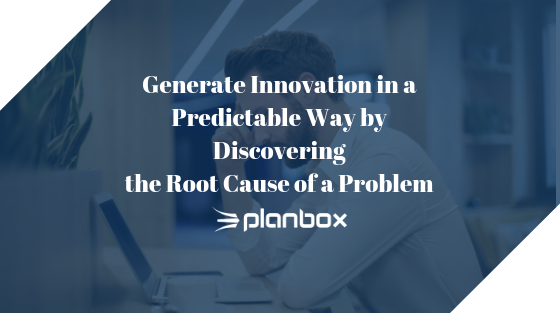Innovation is at the center of an organization’s health as a whole, and part of this health is the ability to solve problems. However, you cannot solve problems if you are not even aware of them. Problem discovery is necessary for a healthy, successful business to flourish. Innovation teams should view these problems as innovation opportunities to continue improving the functions and processes of the business. Sometimes the problems in your organization are clear and obvious, but problems can often be unknown or difficult to define. In previous blogs we have discussed agile management methodologies; however, there are methodologies for discovering problems in your organization as well. Planbox’s discovery central methodology helps find the breakthrough insights that unlock innovation in your business. In this article, we will discuss how to use the Planbox discovery central methodology to discover problems in your organization.
What is Discovery Central Methodology?
The goal of discovery central is to consistently generate breakthrough innovation in a predictable way. In order to do this, discovery central uses methods and software tools to unlock and actualize the creative process of the human mind. This requires your team to look beyond the surface of your organization and uncover the deeper truths about your customers, products, and markets. Through an emphasis on virtual and physical collaboration, this methodology encourages your innovation team to maximize their creative potential. These breakthroughs can occur within any department or aspect of your business, such as business models, products, technologies, collaboration, and customer service.
Discovery central makes you ask the Six Ws (who, what, when, where, why, how) as you discover and evaluate problems. The Six Ws is a well-known business framework that organizations of all sizes have utilized to discover the root cause of problems, and to get the complete story on a subject. We discuss how to best use the Six Ws framework in our previous blog Inverse the Six Ws for Problem Discovery. Furthermore, this methodology provides 4 specific steps to guide you through problem discovery: create clues, expand meanings, connect hunches and discover insights.
Step 1: Create Clues
The initial ‘create’ step helps you acquire numerous diverse inputs. It begins by assembling clues, which are the building blocks of insights. In this case, more is better. Try to come up with as much relevant knowledge as possible without judging or analyzing it just yet. Clues include things like information trapped in data silos and observations from first-hand experience. Data silos are often the biggest blind spot when trying to look for problems. Once you have exhausted brainstorming, your collected information moves to the next step.
Step 2: Expand Meanings
Taking the information you have gathered from the first step, ‘expand’ helps you explore and interpret deeper meanings behind the information. The important questions to ask now are, “what does this mean?”, “why did this happen?”, or “how did this happen?”. Analyzing the meaning in clues helps make possible applications apparent. The innovation team needs to think outside the box and approach this step with new perspectives. Finding the deeper meaning will help to unlock breakthrough innovation.
Step 3: Connect Hunches
Once you have unlocked deeper truths, you can uncover hidden motivations. Connecting clues from the first step to meanings from the second step will develop hunches. These hunches are new beliefs or new ways to interpret the knowledge at hand. It is interesting that some very ordinary or obvious facts might actually be hiding valuable information. It is important that insights that integrate technology, collaboration and trends are revealed. Integrated insights will help you see the full picture and the context in which the problem was created.
Step 4: Discover Insights
The final step refines everything into key insights for the business. This is the most important step in the process and it is very crucial that it is done right. Also, this can be seen as your “aha” moment of problem discovery. Once you have narrowed down your hunches and decided which ideas to implement, your problem should be well defined and ready for a solution. Possibly the most important step in this process is transitioning your promising opportunity into an active innovation project.
Want to learn more about the benefits of the discovery methodology? Explore a real-world example whereby a New Zealand hemp producer realized 31 groundbreaking innovations using the Planbox Discovery Central platform.
Blog Sources:
https://digileaders.com/problem-discovery-overlooked-piece-innovation-puzzle-public-sector/
https://www.innovationexcellence.com/blog/2018/07/23/the-power-of-problem-exploration/

